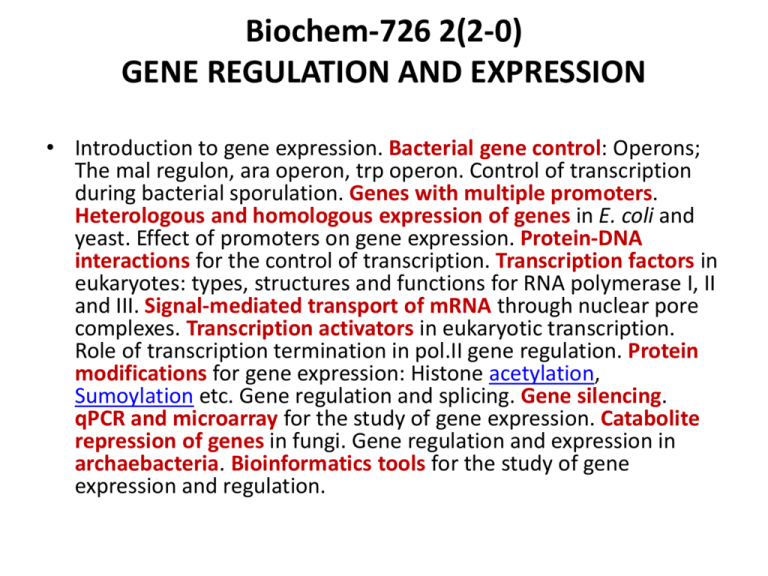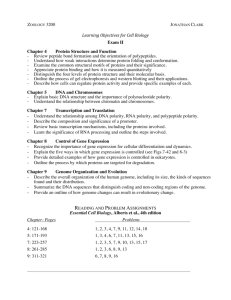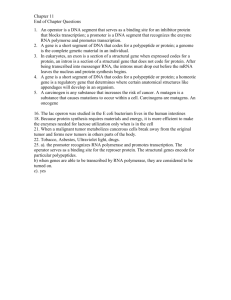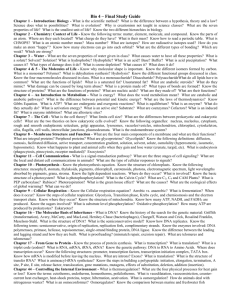in vivo gene expression.pdf
advertisement

Biochem-726 2(2-0) GENE REGULATION AND EXPRESSION • Introduction to gene expression. Bacterial gene control: Operons; The mal regulon, ara operon, trp operon. Control of transcription during bacterial sporulation. Genes with multiple promoters. Heterologous and homologous expression of genes in E. coli and yeast. Effect of promoters on gene expression. Protein-DNA interactions for the control of transcription. Transcription factors in eukaryotes: types, structures and functions for RNA polymerase I, II and III. Signal-mediated transport of mRNA through nuclear pore complexes. Transcription activators in eukaryotic transcription. Role of transcription termination in pol.II gene regulation. Protein modifications for gene expression: Histone acetylation, Sumoylation etc. Gene regulation and splicing. Gene silencing. qPCR and microarray for the study of gene expression. Catabolite repression of genes in fungi. Gene regulation and expression in archaebacteria. Bioinformatics tools for the study of gene expression and regulation. SUGGESTED READINGS •Lesk, A. M. 2002. Introduction to bioinformatics. Oxford Univ. Press, U.K. •Lodish, H., A. Berk, C. A.Kaiser, M. Krieger, M. P. Scott, A. Bretscher, H. Ploegh and P. Matsudaira, P. 2008. Molecular Cell Biology. 6th Ed. Freeman W. H. USA. •Nelson, D.L and M.M. Cox. 2008. Lehninger Principles of Biochemistry. 5th edition, Worth Publishers, New York •Sambrook, J. and D. W. Russell. 2000. Molecular cloning, a laboratory manual. Cold Spring Harbor Laboratory Press, N. Y. •Talbot, N. 2001. Molecular and Cellular Biology of Filamentous Fungi. Oxford university press •Wagner, R. 2000. Transcription Regulation in Prokaryotes. Oxford university press •Watson, J. D., Baker, T. A., Bell, S. P., Gann, A., Levine, M. and Losick, R. 2007. Molecular Biology of the Gene. 5th Ed. Pearson/Benjamin Cummings, CA. •Weaver, R. F. 2008. Molecular Biology. 4th edition. McGraw Hill, USA. Gene Expression • Prokaryotic gene expression – Lac operon – Trp operon • Eukaryotic gene expression • Heterologous gene expression Domain Swapping Join Pro-rich domain of CTF1 to DNAbinding domain of Sp1 • Another example: – Replace DNA-binding domain of Gal4p with DNAbinding domain of E. coli LexA repressor – No binding at UAS neither activation of GAL genes – Activation of the genes may take place when UAS sequence is replaced by a LexA recognition site Regulatory proteins • 104 to 106 times higher affinity • Discrete DNA binding domains – Include one or more of a relatively small group of recognizable and characteristic structural motif • Amino acid side chains often hydrogenbonding to the DNA basis with Asn, Gln, Glu, Lys, Arg residues • However, no simple amino acid-base code • DNA binding domains of regulatory proteins tend to be small (60-90 aa residues) – Structural motifs within these domains are smaller still…… • The DNA binding sites for regulatory proteins are often inverted repeats of a short DNA sequence (palinderome)----- at which multiple (usually two) subunits of a regulatory protein bind cooperatively. – Lac repressor however functions as a tetramer DNA binding motifs • There are several; two are: • Helix-turn-helix – 20 aa in two short α-helical segments each 7-9 aa residues long separated by a β-turn • Zinc finger – ~30 aa residues form an elongated loop held together by a single Zn2+ ion—coordinated to four of the residues (4 Cys or 2 Cys and 2 His) – Zn does interact with DNA but stabilizes – Multiple zine fingers are found in DNA binding proteins • Homeodomain: A type of DNA-binding domain—transcriptional regulator • 60 aa long; highly conserved in euk • DNA-binding segment of the domain is related to helix-turn-helix motif Protein-protein interactions • Two important structural motifs mediating protein-protein interactions are: – Leucine zipper – Basic helix-loop-helix • Leucine Zipper – An amphipathic α helix with a series of hydrophobic aa residues concentrated on one side – The alpha helices have Leu residues at every 7th position—forming a straight line along the hydrophobic surface – Regulatory proteins with leucine zippers often have separate DNA-binding domains with high conc of basic aa (Lys or Arg) – Lucine zippers are found in many euk and prok proteins • Basic-helix-loop-helix – Motif in Euk regulatory protein – Conserved region of ~50 aa residues important in both DNA binding and protein dimerization – Two short amphipathic α helices linked by a loop of variable length Additional domains for protein-protein interaction • At least three types of additional domains characterized primarily in euk – Glutamine-rich – Proline-rich – Acidic domains • Gal4p—contains a zinc finger-like structure in its DNA-binding domain – Binds to UAS– a palindromic sequence ~ 17 bp – Having acidic activation domain • SP1 – a trancription activator for a large No. of genes in higher euk – DNA binding site – GC box (consensus GGGCGG) near TATA box – Its DNA binding domain contains 3 zinc fingers – Two other domains – function in activation– 25% of their residues are Gln---- thus Glutamine Rich Domains • CTF1 (CCAAT-binding transcription factor 1) – belongs to a family of transcription activators – Bind a sequence CCAAT site (consensus TGGN6GCCAA) – DNA binding domain contains many basic aa residues – A proline-rich activation domain – Pro more than 20% of the amino acid residues Inter- and intracellular signals • Steroid, retinoid and thyroid hormones—cross plasma membrane by simple diffusion– reach nucleus– bind to specific receptor protein– hormonereceptor complex binds to specific DNA sequence– hormone response elements (HREs) • The hormone receptors have a highly conserved DNA binding domain with two zinc fingers • Ligand binding region of the receptor protein – At carboxy terminus – Quite specific to a particular receptor • Glucocorticoid receptor only 30% similar to estrogen receptor and 17% to thyroid hormone receptor – Size of the ligand-binding region varies • 25 aa residues in VitD receptor; 603 aa residues in mineralocorticoid receptors An unusual coactivator: Steroid receptor RNA activator (SRA) a ~700 nucleotide RNA acts as a part of ribonucleoprotein ChREBP (carbohydrate response element binding protein) PEP carboxykinase promoter region Ethylene signaling in Arabidopsis The JAK-STAT transduction mechanism for the erythropoietin receptor Transcription factors with significant roles in plant stress tolerance Transcription factor TaSnRK2.4 Source Wheat to Arabidopsis ANAC092 Stress Reference Drought/salt/freezing (Mao et al., 2010) Salt (Balazadeh et al., 2010) Arabidopsis CaRAV1 Pepper Salt/osmotic (Lee et al., 2010) GmDREB1 Soybean to transgenic alfalfa Salt (Jin et al., 2010) Trihelix transcription factors GmGT-2A and GmGT-2B Soybean to transgenic Arabidopsis Salt/freezing/drought (Xie et al., 2009) R2R3 MYB Arabidopsis Salt/drought (Ding et al., 2009) NAC transcription factors NAM, ATAF, CUC Rice Salt/low temperature/drought (Fang et al., 2008) Basic-leucine zipper (bZIP) factors GmbZIP132 Soybean Salt/drought (Liao et al., 2008) WRKY-type factors GmWRKY13 GmWRKY21 GmWRKY54 Soybean to transgenic Arabidopsis Salt/mannitol Cold Salt/drought (Zhou et al., 2008) SNAC2 (NAC type) Rice Salt/drought/cold/wounding/ABA (Hu et al., 2008) Homeodomain-leucine-zipper (HD-Zip Cotton Salt (Ni et al., 2008) AtMYB44 Arabidopsis salt/dehydration/low temperature (Jung et al., 2008) MtZpt2-1, MtZpt2-2 Barrel Clover (Medicago truncatula) Salt (de Lorenzo et al., 2007) OsNAC6 (NAC type) Rice Salt/dehydration (Nakashima et al., 2007) Zat12 (zinc finger) Arabidopsis Salt/cold/oxidative/osmotic/high light/heat (Davletova et al., 2005) 40 transcription factor genes Arabidopsis Salt/drought/cold (Seki et al., 2002b) CREB (cAMP response binding protein) Yeast-two hybrid Translational control of genes 1. Ttanslational initiation factors are subject to phosphorylation by protein kinases. The phosphorylated forms are often less active and cause a general depression of translation in the cell. 2. Some proteins bind directly to mRNA and act as translational repressors, many of them binding at specific sites in the 3’ untranslated region (3’UTR). So positioned these proteins interact with other translation initiation factors bound to the mRNA or with the 40S ribosomal subunit toprevent translation initiation Translational regulation of eukaryotic mRNA 3. Binding proteins, present in eukaryotes from yeast to mammals, disrupt the interaction between elF4E and eIF4G (see Fig. 27-27). The mammalian versions are known as 4E-BPs (eIF4E binding proteins). When cell growth is slow, these proteins limit translation by binding to the site on eIF4E that normally interacts with eIF4G. When cell growth is slow or increases in response to growth factors or other stimuli, the binding proteins are inactivated by protein kinase-dependent phosphorylation. 4. RNA-mediated regulation of gene expression often occurs at the level of Translational repression Catabolite repression Schmoll M and Kubicek CP. 2003. Regulation of Trichoderma cellulase formation: Lessons in molecular biology from an industrial fungus. Acta Microbiol Immuhnol Hung. 50(2-3): pp: 125-45 Cellulases gene expression in fungi • Hypocrea jacorina (Trichoderma reesei)……most studied fungus for cellulases production • Glucose represses the cellulases production • Sophorose (β-1,2-glycosidic bond) is natural inducer of cellulases, formed by transglycosylation of cellobiose cbh1 promoter • Cre1 is repressor protein; it is similar to CreA of Aspergillus nidulans and Mig1 of S. cerevisiae • Cre1 is a phosphoprotein; glucose leads to phosphorylation of Cre1 (at Ser241) which binds to the promoter region • Two Cre1 binding sites are there on cbh1 promoter; one at -700 and other at -1000 Two activators of Cbh1 • Ace1…Activator of cellulase gene expression; a DNA binding protein (3 zinc finger motifs of Cys(2)-His(2) type – At least 8 binding sites of Ace1 are present in cbh1 promoter…..recognizes AGGCAAA and some AGGCA sites • Ace2…Also a DNA binding protein of Zn finger class – Ace2 binds to GGTAATAAA site at -779 cbh2 regulation • CAE (cbh2-activating element) is a nucleotide sequence 5’ATTGGGTAATA that binds to a protein complex – At least one copy of CCAAT in template strand or GTAATA on coding strand is needed adjacent to CAE – Different proteins bind to CAE • CCAAT motif binds to HAP2/3/5 (Heme activated protein) • HAP4 binds directly to HAP2/3/5 trimer xyn1 and xyn2 promoters for xylanase gene expression • XlnR is transcriptional of A. niger xylanolytic system; it is Zn binnulear (Zn2Cys6) cluster protein – Controls transcription of many xylan degrading gene – Also controls eglA and eglB genes Mach, RL, Zeilingers S. 2003. Regulation of gene expression in industrial fungi: Trichoderma. Appl Microbiol Biotechnol. 60(5): 515-22 Real Time PCR (Quantitative PCR; Kinetic PCR PCR product depends on template For twice as much initial template (2T), there is twice as much PCR product in exponential phase. For 4xT, there is 4x PCR product, etc. PCR product 10 4T 2T T 0 0 5 10 Cycle number 15 20








